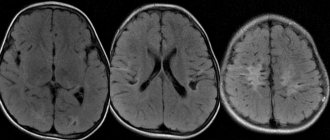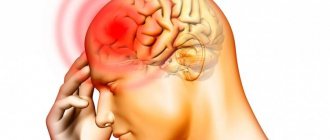Vascular origin is not an independent disease. Pathological processes occur when blood circulation in the brain area is impaired. The disease develops against the background of problems associated with blood vessels. Patients develop characteristic signs indicating the presence of serious pathological processes. It is necessary to consult a doctor and undergo appropriate treatment.
Characteristics of the pathology
In case of cerebrovascular accidents caused by various reasons, doctors diagnose vascular origin. This is not a specific disease of the circulatory system, but changes in the structure of capillaries, veins and arteries. They provoke severe symptoms and oxygen starvation, shooting or aching pains, deterioration of attention and hearing.
Depending on the cause and nature of the pathological changes, genesis causes different disorders:
- Organic. They provoke attacks of nausea, dizziness, and vomiting.
- Individual affected areas. Functional disorders of vision, thinking, decreased memory concentration.
To function properly, the brain requires a constant flow of oxygen, nutrients and amino acids. It is washed by a whole network of large and small vessels that penetrate the medulla.
In various diseases, part of the capillaries or certain sections of veins die and collapse, disrupting blood flow. This leads to the appearance of severe pathologies:
- Transistor disorders that impair human coordination and fine motor skills.
- Death of entire sections of neurons, ischemia of the medulla.
- Formation of an aortic aneurysm supplying the brain.
- Ischemic stroke.
- Irreversible focal changes.
The last disorder of vascular origin is the most dangerous: in many cases it ends in death or severe disability of the patient.
Important! Prolonged deterioration of blood circulation is fraught with an ischemic form of stroke, in which entire areas of the brain responsible for speech, motor skills or breathing die and cease to function.
What is needed to make a diagnosis
In order to make an accurate diagnosis if a vascular disease of the brain is suspected, doctors prescribe the patient to undergo tests such as MRI and ultrasound, as well as a complex neurological examination.
In order to determine the symptoms of the disease, doctors prescribe studies of the electromagnetic activity of certain areas of the brain - this includes Doppler sonography, the use of radionuclides and spectroscopy.
But the only study that is carried out in any case is MRI, which allows you to show accurate and complete information about the pathology. The operating principle of MRI is based on the transmission of echo signals from all organs and systems.
An excellent means of obtaining information about the state of cerebral vessels when diagnosing vascular genesis is examination using magnetic resonance angiography. This examination method allows you to diagnose the presence of structural changes in the gray matter and analyze all the physical and chemical processes occurring in the brain.
An equally common method of research and making an accurate diagnosis is the use of electroencephalography - in this case, doctors remove and record fluctuations in electrical potentials that occur in the brain.
A CT scan involves scanning the brain with an X-ray - in this case, doctors take readings of how quickly the X-rays penetrate the brain tissue. It is with its help that it is possible to establish both congenital and acquired problems with the vascular network of the brain.
Classification of violations
With vascular genesis of the brain, pathological disorders of the structure of blood vessels can take on different forms:
- Anomalies of the development of the main arteries. There are a number of diseases in which the aorta is dissected, compressed by a tumor, or has an increased length, which impairs blood flow.
- Destruction of capillaries and veins. When blockage or dissection occurs, many small lesions occur. This is how a microstroke develops with multifocal damage to different parts of the brain.
- Encephalopathy of the subcortical layer. Negative changes occur when blood vessels are blocked by atherosclerotic plaques. Due to improper nutrition, the structure of the brain substance is disrupted, and certain functions malfunction. In neurology, the problem is called “Binswanger’s disease” and is considered the initial stage of senile dementia.
Therapy and rehabilitation
The specialist prescribes drug treatment to patients after a complete examination, based on the established diagnosis. While taking medications, patients are advised to receive a balanced diet.
General treatment plan:
- Compliance with the established daily routine. The patient should be protected from stress and excessive physical activity. In case of a transient ischemic attack, the patient is advised to remain in bed until the signs of the disease completely disappear.
- Diet food. Fried and fatty foods, which provoke various problems associated with the functioning of the cardiovascular system, should be excluded from the diet
. All patients are prescribed a strict diet during treatment for genesis. - Drug therapy. Drugs are selected for each patient, taking into account the development of pathological processes, vascular damage and lesions. Medicines restore heart function and brain function.
- Surgical intervention. The operation is performed if drug therapy does not produce a positive result. Specialists remove atherosclerotic plaques or affected areas of blood vessels.
After treatment or surgery, the patient will need time for recovery and rehabilitation. Additionally, experts recommend attending physiotherapeutic procedures and performing therapeutic exercises
. During the rehabilitation period, patients are under constant medical supervision.
Causes of pathology
Having figured out what it is - vascular genesis, it is necessary to carefully consider the diagnosis and search for the main cause of pathological circulatory disorders of the brain. In the first place is the thickening of the vein walls caused by chronic hypertension. With elevated blood pressure, irreversible changes occur. They lose elasticity and are less able to withstand spasms and weather changes.
In second place by the number of diagnosed cases is atherosclerosis. When the disease occurs, lipid-fat metabolism is disrupted, and the number of “bad” cholesterol molecules in the blood increases. It deposits on the walls of blood vessels, clogging the ducts and reducing the flow of blood to the tissues.
When it breaks down, a blood clot is formed that can completely cut off the supply to the brain.
Among other diseases that affect the development of the problem, doctors identify:
- chronic anemia;
- pathologies of the cardiovascular system;
- aneurysm of the main artery;
- diabetes;
- vegetative-vascular dystonia;
- cervical osteochondrosis.
Diseases and deterioration of the condition of blood vessels are sometimes a consequence of an incorrect attitude towards one’s own health:
- obesity of varying degrees;
- smoking;
- alcohol abuse;
- constant stress at work and in the family;
- head and spine injuries;
- unwillingness to follow doctors' recommendations for hypertension.
The state of blood flow is affected by hormonal imbalances in diseases of the thyroid gland, adrenal tumors, and the onset of menopause in women.
Important! In rare cases, the cause is neurological. In such patients, vascular genesis manifests itself against the background of neurosis or depression, chronic insomnia.
A rare cause of genesis is paroxysmal hemicrania. As the disease progresses, the speed of blood flow in the middle cerebral artery decreases. Irreversible changes in the brain occur, affecting memory, visual acuity and hearing. This is a manifestation of disturbances in the functioning of the autonomic system due to hormonal imbalance, vitamin deficiency, chronic anemia or neurosis.
Causes, symptoms and methods of treatment of vascular genesis of the brain
A good blood supply to the brain is the main component of its full functioning. If violations occur in this process, first minor and then sometimes irreversible disruptions in the work of this body inevitably occur. One of the manifestations of such disorders is the medical diagnosis – vascular genesis.
Vascular genesis
Vascular genesis is not an independent disease, but only a consequence of the development of vascular diseases. The brain is supplied with nutrients and oxygen through blood, which flows through several arteries.
In addition to the arteries, the venous system also plays an important role in transporting the required amount of blood to the brain. Vascular pathology, which entails negative changes in the blood supply system to the brain, is called “vascular genesis.”
Depending on the nature of the patient’s brain damage, they can diagnose:
- Organic or general pathological changes. They are quite often accompanied by severe headaches, including dizziness and nausea.
- Focal pathologies. If only certain areas of the brain are affected, patients will experience completely different signs of the disease. For example, with small focal leukoencephalopathy of vascular origin, the patient experiences damage to the white matter, which, in turn, leads to senile dementia.
Depending on the type of cerebral circulatory disorders, it is customary to distinguish:
- Transitory. In this case, it is customary to talk about general cerebral disorders or small-focal vascular disorders. The former cause severe headaches with nausea and even vomiting. The latter cause disruptions in the motor functions of organs, and sensitivity may be lost in certain parts of the body. This type of disorder is reversible and can be easily treated with complete recovery.
- Narrowing of the artery lumen. This pathology greatly affects the functioning of the area of the brain associated with this artery. Ischemic pathologies are often observed here. Treatment can be lengthy and complex, including surgical interventions.
- Aneurysm rupture. This process leads to hemorrhage into the brain cavity, the consequence of which will be a stroke, which can be hemorrhagic or ischemic in origin.
Reasons why vascular genesis of the brain develops
Considering that this pathology consists of insufficient blood supply to the brain, the doctor, in order to conduct effective treatment, is faced with the question of what led to the development of this disease. Most often, this situation is caused by hypertensive phenomena and the development of atherosclerosis of the vessels through which blood is delivered to the brain.
In the presence of hypertensive pathology, the patient develops thickening of the walls of blood vessels, which means that their lumen narrows significantly. In especially severe cases, sometimes complete stenosis of one or another vessel occurs, and the circulatory process can completely stop.
When the body is damaged by atherosclerosis, which, in turn, develops due to disruptions in the patient’s fat metabolism and the appearance of cholesterol deposits on the walls of blood vessels, normal blood flow becomes impossible.
This leads to insufficient blood supply to the brain. In the most severe situations, due to the breakdown of cholesterol plaques, a blood clot can form in any of the blood vessels.
In addition, other diseases lead to the development of vascular origin:
- aneurysm of the arteries supplying the brain;
- systemic diseases;
- pathological disruptions in the functioning of the heart;
- diabetes;
- anemia of any type;
- vegetative-vascular dystonia;
- osteochondrosis, leading to pinching of the paravertebral arteries.
The most common causes of these disturbances in the functioning of the body are:
- Constantly or frequently rising blood pressure;
- high blood glucose levels;
- head injury;
- psycho-emotional overload of the patient;
- bad habits - smoking, drinking alcoholic beverages in excess, overeating;
- disorders of the musculoskeletal system.
Sometimes disturbances in the blood supply to the brain occur as a result of improper functioning of the nervous and endocrine systems. Such disorders can occur with the development of chronic fatigue syndrome.
Classification of the disease
In modern medicine, it is customary to distinguish the following types of insufficient blood supply to the brain:
- Binswanger's disease. This type of vascular circulation disorder leads to insufficient blood supply to the white matter of the brain. With this disease, the destruction of neurons occurs, which will soon lead to senile dementia - dementia. The first alarming symptom is severe pressure drops within one day. Then memory begins to deteriorate greatly.
- Pathological processes in the great vessels. Such disorders include narrowing of the lumens, strong bends, and thrombosis of blood vessels, which lead to a lack of circulating blood.
- Consequences of micro-strokes. When small vessels are blocked, there is a clear deterioration in the nutrition of the gray or white matter of the brain. This process cannot happen for a person without consequences. The patient may experience both general signs of the disease and disruptions only in certain body functions.
Signs of vascular origin
Manifestations of this disease at the first stage very rarely cause serious concern and seem to be a mild malaise against the background of fatigue or other illnesses.
First signs. Problems with the blood vessels of the brain most clearly begin to appear after increased emotional or physical activity. Also, prolonged exposure to a poorly ventilated room can trigger symptoms. The patient begins to feel:
- pain, noise and heaviness in the head;
- dizziness;
- sleep disturbance;
- high fatigue.
At this stage, an examination is usually started to exclude dystonia, neurosis or atherosclerosis. Only then will there be a suspicion of vascular genesis of the brain.
Mental disorders. Disorders of this type begin to appear only after a fairly long development of the disease. This can be expressed in the following manifestations:
- Increased irritability. This symptom is expressed in intolerance to loud sounds and bright lights.
- Deterioration of sleep. When the outflow of venous blood decreases, the patient develops prolonged and severe headaches. Dizziness is often observed, which intensifies with a sudden change in body position. Falling asleep takes a long time, and sleep time is very short - no more than four hours. This state of affairs leads to a deterioration in overall health and the development of chronic fatigue.
- Deterioration of mental functions. With prolonged circulatory failure in the white matter of the brain, the patient's memory and ability to purposefully plan begin to decline.
- Personal changes. As the disease progresses, the patient experiences a clear change in character. The main character traits begin to appear very strongly, and everything else gradually disappears. At this stage, a person develops very strong anxiety, suspiciousness and loses confidence in his actions.
With vascular genesis, all manifestations related to mental personality disorders are very treatable, which is clearly different from true mental illnesses.
Differences between headaches
As noted earlier, this disease is almost always accompanied by headache, which can vary significantly.
If the supply of arterial blood to the brain is disrupted, the pain occurs in a separate focus and is pulsating in nature with severe tinnitus. Gradually, the intensity of the pain attack decreases and turns into a dull, bursting pain.
In case of disturbances in venous blood flow, the patient experiences a dull heaviness throughout the head. The pain is clearly worse in the morning when standing upright or when coughing.
Diagnosis of the disease
This disease is extremely difficult to diagnose in the early stages, especially with single changes in the brain. Quite often, during examination, doctors do not find any significant deviations from the norm. But if there are obvious disturbances in your well-being, you should not calm down. It is necessary to continue further, more detailed examination.
Survey forms:
- computed tomography makes it possible to examine vessels for the presence of congenital or acquired vascular pathologies;
- Magnetic resonance imaging makes it possible to get a complete picture of the condition of blood vessels;
- magnetic resonance angiography is performed to determine the state of the gray matter and the presence of small focal changes in the brain of vascular origin;
- Dopplerography is carried out to clarify the speed of blood flow;
- electroencephalography diagnoses the structure of the brain of a sick person;
- spectroscopy allows you to analyze processes (biochemical) in brain tissue.
If the patient has obvious functional disorders of other organs, he is referred to other specialists for consultation. For example, if vision deteriorates, the patient is referred to an ophthalmologist.
When conducting any type of examination, if there is a suspicion of this disease, the patient is also prescribed a detailed examination of cardiac activity.
Symptoms of the disease
In most cases, the first manifestations of genesis occur after a situation that provoked a sharp jump in blood pressure: a quarrel, emotional distress, physical overload during training. Characteristic symptoms:
- pressure surges above 140/90 mmHg. Art.;
- dizziness;
- hand tremors;
- disturbing sleep;
- heart rhythm disturbance;
- absent-mindedness and memory impairment;
- muscle weakness;
- headaches, spasms in the temples.
With some diseases, a person’s behavior and character changes: he becomes anxious and irritable, nervous, and loses his temper over trifles. With severe damage, signs of mental problems arise that require specialized help.
One of the most severe manifestations of vascular genesis of the brain is pseudoneurasthenic syndrome. Attacks of panic or aggression appear associated with disruption of blood flow to certain areas. Among the characteristic signs: suspiciousness, irritability, constant dissatisfaction with oneself and loved ones, unreasonable anxiety. Headaches and surges in blood pressure only worsen the condition.
The first signs of vascular insufficiency
As a rule, the initial symptoms of vascular insufficiency of the brain appear after prolonged emotional and physical stress or prolonged exposure to a poorly ventilated room.
As the initial stage progresses, moments of increased excitability of the nervous system are observed
The first symptoms in patients are:
- dizziness;
- headache;
- heaviness and noise in the head;
- sleep disorder;
- increased fatigue.
At this stage, there are no significant neurological symptoms. The appearance of the first signs of cerebrovascular disease serves as the basis for a comprehensive diagnosis in order to exclude atherosclerosis, neurosis and dystonia.
Diagnostic methods
Pathological disorders in the white matter of the brain cannot be diagnosed without modern equipment. The most effective methods:
- MRI of the head and pituitary gland using a contrast agent;
- Ultrasound of neck and brain vessels;
- dopplerography;
- electroencephalogram;
- CT of large vessels.
Doctors recommend taking general and clinical blood tests. To prescribe the correct treatment, you need to know your cholesterol and hemoglobin levels and check your hormonal levels. For clarification, an ECG of the heart, daily blood pressure monitoring and other “narrow” procedures may be required.
Stages
There are several stages that indicate the development of a disease associated with insufficient nutrition of the brain. The dynamics may be different, as it is influenced by several factors, such as heredity, lifestyle, environmental conditions, and so on.
At the first stage of the disease, people often have headaches, irritability, forgetfulness and sleep disturbances. In the second stage, memory deteriorates more severely; a person can sleep during the day, but at night sleep is disturbed. Obsessive thoughts also appear, the patient begins to think about the same problem.
Nature of the headache
When diagnosing, doctors are interested in the nature of the headache. This helps to predict the disease and reduce the examination time:
- With venous plexus stenosis, a person feels a deafening and dull pain. It worsens when standing, with sudden movements or coughing.
- With pathologies of arteries and great vessels, pain is concentrated in one sector. There is pulsation and deafening noise, and hearing deteriorates. It’s as if my head is bursting from the inside.
- With swelling caused by excess blood flow in the veins, spasms occur in the back of the head.
- With inflammation or narrowing of the superficial artery, the localization of pain is the temples. When palpating the area with the fingertips, the sensations become dull.
If pain occurs in the jaw near the ear, we may be talking about Horton's disease - a consequence of focal brain damage due to vascular origin. This form of vasculitis provokes inflammation of the temporal and carotid arteries, which develops in middle-aged people with loss of vascular elasticity.
Important! Vascular genesis often manifests itself during menopause in women in the form of painful headaches. Patients complain of severe spasms in the back of the head and temples, which are called “cephalalgia.” This is due to a sharp decrease in hormones and a restructuring of many body systems.
Clinical picture
Common signs of impaired blood supply to the brain include the following:
- Arrhythmia. The patient's heart rate increases even with complete rest.
- Blood pressure rises regularly and for no apparent reason.
- There is a general feeling of weakness in the body.
- Headaches appear.
- Attention is impaired. It is difficult for patients to concentrate on the problem and highlight the most important aspects from the entire amount of information.
- Frequent dizziness.
- Patients get tired quickly.
Symptoms of vascular origin depend on the nature of circulatory disorders in the brain area. The doctor can make an accurate diagnosis based on the pain syndrome. The first signs of pathology in patients appear along with high blood pressure
.
Ringing in the head and throbbing pain indicate disturbances in the area of the craniocerebral artery
.
In the later stages of the disease, characteristic symptoms also appear
. People complain of a dull pain accompanied by nausea.
In case of disturbances in the occipital part of the head, the veins of the brain fill and the patient feels a strong heaviness in the indicated area. Vascular genesis is characterized by mental disorder , sleep becomes superficial and short-term. After a night's rest, the body remains feeling tired and weak.
With the formation of supratentorial foci of gliosis of vascular origin, the patient develops severe headaches, which intensify over time. The work of not only the human brain, but also other internal organs is gradually disrupted
. Injuries and lack of adequate treatment lead to tumor formation.
Individual manifestations:
- increased sensitivity to light and sound;
- constant irritability;
- attention is impaired;
- memory problems appear;
- tearfulness.
As pathological changes progress, symptoms intensify. Doctor's help and treatment are required.
Treatment of diseases
If hypertension or atherosclerosis occurs, it is necessary to strictly follow the recommendations of doctors. The sooner treatment begins, the faster the symptoms will go away:
- For spasms of veins and arteries, antispasmodics are recommended to improve the condition: No-Shpa, Papaverine.
- It is necessary to treat blood pressure with a course of Captopress, Captopril. Veroshpiron and diuretics help relieve swelling.
- When venous blood flow decreases, Eufillin and Pentoxifylline are used in long courses.
- Anticoagulants help improve blood composition in atherosclerosis.
- For focal changes, nootropic drugs are selected individually.
Moderate exercise, swimming and walking become a kind of training for the circulatory system, increasing tone and endurance. Any visual impairment due to vascular origin requires additional treatment under the supervision of an ophthalmologist.
Using Nimesil for headaches
Neurologists do not advise enduring pain; they suggest potent drugs. Nimesil is a nonsteroidal anti-inflammatory drug that inhibits the synthesis of hormones that provoke spasms. The main substance nimesulide is recommended for vasculitis, migraines, VSD, it reduces discomfort and increased muscle tone.
But the medicine requires strict adherence to the dosage: side effects negatively affect the liver, digestive system, and can cause heart rhythm disturbances. If necessary and on the recommendation of a doctor, Nimesil can be replaced with the following medications - Nurofen, Ibuklin, Ibuprofen.
A few words about the consequences
The disease described in this article is very dangerous, so at the first signs it is very important to contact a neurologist. Your doctor will tell you where to get an MRI of the brain. This procedure is usually carried out in the hospital itself or at a testing center. In any case, do not ignore it, as it will help establish an accurate diagnosis.
Focal changes in the brain substance of a dyscirculatory nature can lead to very serious consequences. The presence of this disease can affect the entire body as a whole: blood pressure will increase, and the risk of such a dangerous condition as a stroke will also increase.
Preventive actions
Constant prevention of hypertension, treatment of atherosclerosis and vascular diseases help reduce complications. Among the recommendations of neurologists:
- complete rest;
- active lifestyle;
- maintaining a diet for diabetes, atherosclerosis;
- daily measurement of pulse and pressure, control of sugar levels and basic hormones;
- massage courses for osteochondrosis.
It is necessary to learn to withstand stress and calmly respond to unusual situations. The doctor will help you choose safe sedatives to normalize the condition without harming the blood vessels.
Many diseases that provoke vascular genesis may not manifest themselves until a certain time. The first symptoms often appear in mature and older people and cause dementia, multiple sclerosis, and stroke. Early diagnosis and prevention will help slow down the development of pathology and prevent irreversible complications.












